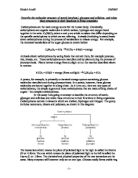Plants produce sugar by converting carbon dioxide and water via photosynthesis. However, when an excess amount of glucose is produced the rest is stored as starch. The plant usually uses the stored starch to use at night when it is unable to photosynthesise because of the lack of sunlight. This is the starch usually stored in the chorloplasts in the leaves. However, starch can be stored in tubers, roots and seeds for prolonged use over time.
Starch is almost essential in our diet because it is a major source of energy. The most common sources of food starch are corn, potato, wheat and rice, and it is found naturally in fruits, vegetables and cereals. Starch can be used as a gelling agent. “It can form a gel after dissolving in hot water” (Starch – Not So Sticky! Biological Sciences Review) In addition “When starch is heated in water, the weaker hydrogen bonds, in the amylose rupture and the starch swells with progressive hydration.” (
Often starch is used as a replacement for fat in many food products because it reduces the calorie value. Before starch is added to foods it is chemically modified and “noxious chemicals are added such as phosphorus oxychloride and adipic anlydride.” (Starch – “Not so Sticky” – Biological Sciences Review) In foods and other products starch is also used to influence or control such things aesthetics, moisture, consistency and shelf life.
Glycogen
Glycogen is the main storage carbohydrate in humans. The primary structure of glycogen resembles that of amylopectin, but glycogen is more highly branched. The body tries to maintain a constant level of glucose in the blood. Therefore excess glucose is polymerised into the polysaccharide glycogen that is stored in the liver and muscle cells.
The diagram above shows the structure of glycogen.
Glycogen is stored in muscle and the liver. Glycogen can act as a short-term energy supply and is a lot more efficient when compared to fat. Glycogen breakdown is triggered when there is a high-energy demand in muscle cells or a low blood glucose concentration in the liver cells. Liver cells release glucose units into the blood stream to maintain the correct blood glucose levels. For example after a period of vigorous exercise glucose levels in the body are quickly used up, however, this is restored by breaking down glycogen in the muscles and liver.
Glycogen’s most important role is for respiration in animals. Glucose and oxygen react together to form a type of energy called ATP. This is essential in life because animals need energy to perform day to day activities. This is why glycogen is stored in the muscles, because energy is always demanding a high amount of energy.
Cellulose
Cellulose is a straight chained molecule linked by glucose residues. Chemically it is a very stable molecule and is insoluble. The monomer that forms cellulose is β – Glucose, which differs from alpha – glucose because the H and OH groups are the other way up. Consequently, this means when a condensation reaction occurs one of the β – Glucose bonds has to be flipped over. Cellulose chains are parallel and they are linked by hydrogen bonds, which then form bundles called microfibrils. This therefore means that cellulose has a high tensile strength and this makes them ideal in forming cell walls in plants.
The diagram above shows the long chain, linked by β – Glucose residues.
Cellulose is part of the plant structure. It helps keep the plant rigid and stable, however, flexible enough to sway. Cellulose is also commonly used in industry. For example it is used in textiles because it has a high tensile strength, therefore the fibres in the textile materials hold together better. Cellulose is used in cotton, linen and acetate. They are also used in plastics such as cellophane and they are also used in food decoration because cellulose is strong enough to keep the structure.
As you can see polysaccharides have a wide range of uses not just economically in industry but structurally and naturally. Starch and Cellulose are the most vastly used polysaccharides in industry and glycogen is a very important energy store in humans.








